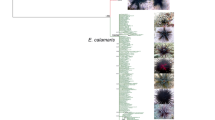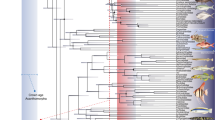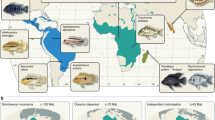Abstract
THE ‘molecular clock’ hypothesis of protein evolution holds that each protein changes at a constant rate, so that the degree of molecular divergence between two species is linearly related to the time for which their lineages have remained separate1. This assertion, however, has been challenged repeatedly by authors who discovered taxa and peptides in which the proposed uniformity of molecular evolution did not hold2,3, who noted that biochemically and palaeontologically determined dates of separation between lineages conflicted4,5, introduced tests that pointed to significant variation in the rates of evolution of the same proteins6,7, or dismissed the hypothesis as a confusion of averages with constants8. Others have postulated that, although the same proteins evolve at different rates in different lineages, the average amount of molecular change over many proteins is sufficiently uniform to provide approximate dates for the splitting of two lines of descent9,10. Here I present evidence from sea urchins separated by the Isthmus of Panama which indicates that even this compromise position is not tenable.
This is a preview of subscription content, access via your institution
Access options
Subscribe to this journal
Receive 51 print issues and online access
$199.00 per year
only $3.90 per issue
Buy this article
- Purchase on Springer Link
- Instant access to full article PDF
Prices may be subject to local taxes which are calculated during checkout
Similar content being viewed by others
References
Wilson, A. C., Carlson, S. S. & White, T. J. A. Rev. Biochem. 46, 573–639 (1977).
Goodman, M., Barnabas, J., Matsuda, G. & Moore, G. W. Nature 233, 604–613 (1971).
Jukes, T. H. & Holmquist, R. Science 177, 530–532 (1972).
Radinsky, L. Science 200, 1182–1183 (1978).
Simons, E. L. Ann. N. Y. Acad. Sci. 167, 319–331 (1969).
Langley, C. H. & Fitch, W. M. J. molec. Evolut. 3, 161–177 (1974).
Moore, G. W., Goodman, M., Callahan, C., Holmquist, R. & Moise, H. J. molec. Biol. 105, 15–37 (1976).
Stebbins, G. L. & Lewontin, R. C. Proc. 6th Berkeley Symp. Math. Stat. Prob. V, 23–42 (1972).
Fitch, W. M. & Langley, C. H. Fedn Proc. 35, 2092–2097 (1976).
Dobzhansky, T., Ayala, F. J., Stebbins, G. L. & Valentine, J. W. Evolution (Freeman, San Francisco, 1977).
Gorman, G. C., Kim, Y. J. & Rubinoff, R. Copeia 1976, 361–364 (1976).
Maxson, L. R. & Wilson, A. C. Science 185, 66–68 (1975).
Sarich, V. M. Syst. Zool. 18, 416–422 (1969).
Sarich, V. M. & Wilson, A. C. Science 158, 1200–1203 (1967).
Wilson, A. C. & Sarich, V. M. Proc. natn. Acad. Sci. U.S.A. 63, 1088–1093. (1969).
Kimura, M. & Ohta, T. J. J. molec. Evolut. 1, 1–17 (1971); Nature 229, 461–469 (1971); Genetics, Princeton 73, Suppl. 19–35 (1973).
Kimura, M. Proc. natn. Acad. Sci. U.S.A. 63, 1181–1188 (1969).
King, J. L. & Jukes, T. H. Science 164, 788–798 (1969).
Ohta, T. & Kimura, M. J. molec. Evolut. 1, 18–25 (1971).
Van Valen, L. J. molec. Evolut. 3, 89–101 (1974).
Carlson, S. S., Wilson, A. C. & Maxson, R. D. Science 200, 1183–1185 (1978).
Richmond, R. C. Nature 225, 1025–1028 (1970).
Saito, T. Geology 4, 305–309 (1976).
Webb, S. D. Paleobiology 2, 220–234 (1976); A. Rev. ecol. Syst. 9, 393–426 (1978).
Woodring, W. P. Proc. Am. Phil. Soc. 110, 425–433 (1966).
Chesher, R. H. Bull. biol. Soc. Wash. 2, 139–158 (1972).
Johnson, G. B. A. Rev. ecol. Syst. 8, 309–328 (1977).
Nei, M. Molecular Population Genetics and Evolution (North-Holland, Amsterdam, 1975).
Mortensen, T. Studies of the Development and Larval Forms of Echinoderms (Gad, Copenhagen, 1921).
Emiliani, C., Gartner, S. & Lidz, B. Paleogeogr. Paleoclim. Paleoecol. 11, 1–10 (1972).
Durham, J. W. & Allison, E. C. Syst. Zool. 9, 47–91 (1960).
Fell, H. B. & Pawson, D. L. in Treatise on Invertebrate Paleontology Part U, Vol. 3 (ed. Moore, R. C.) 367–440 (Geological Society of America, Kansas, 1966).
Lovejoy, C. O., Bernstein, A. H. & Heipe, K. G. Science 176, 803–805 (1972).
Hendler, G. Proc. 3rd Int. Coral Reef Symp. 1, 217–223 (1977).
Ewens, W. J. Genetics Princeton 50, 891–898 (1964).
Kimura, M. Genet. Res. 11, 247–269 (1968); Genetics Princeton 61, 893–903 (1969).
Ohta, T. & Kimura, M. Genet. Res. 22, 201–204 (1973); Am. Nat. 109, 137–145 (1975).
Chakraborty, R. & Nei, M. Evolution 31, 347–356 (1977).
Lessios, H. A. thesis, Yale Univ. (1979).
Author information
Authors and Affiliations
Rights and permissions
About this article
Cite this article
LESSIOS, H. Use of Panamanian sea urchins to test the molecular clock. Nature 280, 599–601 (1979). https://doi.org/10.1038/280599a0
Received:
Accepted:
Published:
Issue Date:
DOI: https://doi.org/10.1038/280599a0
This article is cited by
-
Iterative Calibration: A Novel Approach for Calibrating the Molecular Clock Using Complex Geological Events
Journal of Molecular Evolution (2018)
-
Morphological divergence of Eastern Pacific and Caribbean isopods: effects of a land barrier and the Panama Canal
Marine Biology (1989)
-
Population genetic studies of the crown-of-thorns starfish, Acanthaster planci (L.), in the Great Barrier Reef region
Coral Reefs (1988)
-
Molecular clockwork
Nature (1980)
Comments
By submitting a comment you agree to abide by our Terms and Community Guidelines. If you find something abusive or that does not comply with our terms or guidelines please flag it as inappropriate.



